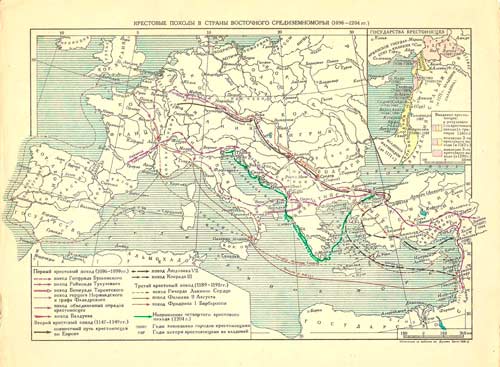The most direct consequence of the Crusades, leaving aside the deaths of millions of people, was the foundation in the East, at the expense of the Muslims and the Byzantine Empire, several Catholic states occupied by French knights and Italian merchants. These Europeans, never reaching large numbers, were driven out, and the only traces of their presence in the East were the ruins of their castles in the ports and mountains of Greece and Syria. But during the two centuries of their dominance in the East, the crusaders established regular relations between the Christians of Europe and the Muslim states.
Crusader states in the East
To transport pilgrims to the Holy Land, the cities of the Mediterranean coast organized transport fleets; the horses, which the crusaders always carried with them, were transported on ships where the hold opened on the side. For protection against pirates, ships equipped in a military way were used, and a whole fleet was sent at once. During the era of the Crusades, there were two flights: one in the spring (large flight) for pilgrims who went to the Holy Land at Easter, the other in the summer. The transportation of pilgrims gave large incomes; therefore the strong cities held her back; it was possible to depart only from certain ports: in Italy - from Venice, Pisa and Genoa, in France - from Marseilles. The Templars were given the privilege of sending one ship on each voyage.
By sea or land, millions of Christians traveled from Europe to the East; the crusade was like an educational journey for them. They came out of their castles or towns more ignorant than our peasants, and suddenly saw great cities, new countries and unknown customs before them. All this awakened their mind and enriched it with new ideas. This is the best acquaintance of Europe with the peoples of the East, borrowing from them some of the arts and customs was also an important consequence of the crusades.
Western Europeans got a more correct idea of Muslims. The first crusaders considered them savages and idolaters, prophet Mohammed- an idol, and later a heretic. In the XIII century. Christians already knew the essence of Islam and recognized Muslim culture as superior to their own.
However, it is difficult to say exactly what Europe owes to the Crusades. Western Christians adopted many inventions and customs from the Arabs and Greeks during the Middle Ages. When you see some oriental custom in Europe, it involuntarily comes to mind that it was brought here by the crusaders; but the crusades are not the only way he could have crossed here. Muslim culture dominated the entire African coast and southern Spain; Christians were in regular trade relations with Egyptian, Tunisian and Spanish Muslims and Byzantine Greeks. We know well what the Christians borrowed from the East; but as regards individual objects or customs, we seldom know whether they passed into Europe through Spain, Sicily, the Byzantine Empire, or the Crusaders. To consider as a consequence and influence of the crusades all the oriental customs that dominated Europe in the Middle Ages means to exaggerate their influence or to bring under this all the relations of Christians with Muslims.

There is no doubt that medieval Europe learned a lot from the Muslim peoples, but it is impossible to determine with accuracy the role of the crusades in this influence of the East on Europe. The only thing that can be confidently considered their consequence is the transfer to the West of those customs that originated in Syria itself; a crossbow, a spear with a baldric, a drum and a pipe are borrowed from weapons; from plants - sesame, apricots (in Italian damasco), charlotte (from Ascalon) and watermelon. In the East, Christians, who until then had all shaved, began to wear beards for the first time. It is also possible that the windmill appeared in Europe from Syria.
In order to recognize each other among a huge crowd of warriors, the knights had to have some kind of distinguishing marks; already and earlier it became a custom to depict some kind of ornament on the shield. During the crusades, these decorations become family signs, which then no longer change. This is how the system of coats of arms came into being. It took shape in the East, as the Eastern words used in it prove: gueules(red) - Arabic word (from guil, pink); Azur(blue) - Persian, sinople(green) - Greek; the gold coin was called bezant(Byzantine gold coin), the Greek cross served as a heraldic cross.
Many other consequences were attributed to the crusades: the beginning of the gradual emancipation of the peasants from serfdom, the strengthening of royal power, the transformation of the feudal system, the development of epic poetry, the enrichment of Italy, even the decline of piety and the weakening of papal power - in a word, almost all the changes that took place in Western states between the 11th and 13th centuries. The crusades, no doubt, had a profound influence on the general course of development of Christian states, but each of these phenomena had more effective and undoubted causes, which should be sought in the history of the states of the West themselves.